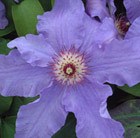Price reductions at Crocus
by Sarah - September 27th, 2009.Filed under: Crocus, Price Reductions.
Reduced products at Crocus

clematis (group 2) was £9.99 now £8.99
Position: full sun or partial shadeSoil: fertile, well-drained soil, neutral soilRate of growth: averageFlowering period: May to JuneFlower colour: deep lavender blueHardiness: fully hardyLarge, deep lavender blue flowers are produced from late spring to early summer, with a second flush in late summer. The variety is ideal for growing up obelisks, walls, fences and pergolas, and even makes a striking display in a pot on the patio. It will happily grow in most spots in the garden but does prefer a sunny wall to climb up.Garden care: Remove dead and damaged stems before growth begins in early spring, cutting all remaining stems back to where strong buds are visible. Apply a slow-release balanced fertiliser and a mulch of of well-rotted garden compost around the base of the plant in early spring.

clematis (group 3) was £9.99 now £8.99
Position: full sun or partial shadeSoil: fertile, moist, well-drained soilRate of growth: averageFlowering period: July to SeptemberFlower colour: purple-blueHardiness: fully hardyThe lightly scented, pale purplish-blue flowers can grow to 8cm across, and are produced prolifically during summer. The prominent creamy yellow centres are surrounded by lightly striped petals – each petal has a darker central stripe along its length, which contrasts well with the pale blue edges. A non-climbing, herbaceous Clematis, which is ideal for scrambling along the ground or through shrubs. Alternatively pot it up and let it spill over the sides.Garden care: Cut back the stems to the base of the plant each winter and apply a mulch of well-rotted garden compost around the plant, avoiding the immediate crown

clematis (group 3) was £9.99 now £8.99
Position: full sun or partial shadeSoil: fertile, moist, well-drained soilRate of growth: averageFlowering period: July to SeptemberFlower colour: violet-blueHardiness: fully hardyA recent and exciting introduction from Japan, the nodding, bell shaped flowers of this cultivar are carried on sturdy stems and can grow to 5cm long. Their rich violet-blue petals have a light lavender edging, and look lovely over a long period from mid summer to autumn. A semi-herbaceous, non-clinging form, which can be trained onto a trellis, or left to scramble scramble amongst the flower border. An easy to grow clematis which flowers prolifically.Garden care: Cut back the stems to healthy buds at the base of the plant each winter and apply a mulch of well-rotted garden compost around the plant, avoiding the immediate crown.

upside-down-tomato-planter was £14.99 now £9.99
An ingenious grow bag that is suspended from above so you can grow tomatoes without needing to stake or weed. It’s ideal for hanging above the patio and porch, and thanks to the innovative design the fruit even ripens nearly a month earlier than anyone else’s! Pest problems, in particular cutworms, are reduced and as the plants hang down there’s no need to bend or search for the fruit. Also ideal for growing cucumbers, peppers, courgettes, aubergines, herbs and even flowers. Measures: 26.5cm Dia x 44cm H

rootgrow was £10.99 now £9.99
This is the first and currently the only plant or soil treatment to be licensed by The Royal Horticultural Society.RHS Gardeners find plants treated with Rootgrow Have superior plant establishment with better natural vigour Overcome re-plant problems more successfully Have better developed root systems Are better able to cope with conditions of drought A single application of Rootgrow will support a plant for its entire lifetime.How do mycorrhizal (pronounced my-cor-y-zal) fungi benefit plants?In its simplest sense mycorrhizal fungi do everything plant roots do, just better. When new plants are planted with Rootgrow it takes only 2-4 weeks under normal conditions for these fungi to start benefiting plants. In that time they attach themselves to the plant’s root system and grow out rapidly into the soil, searching for nutrients and water. They essentially become part of the plant’s own root system. The benefits to plants are; Better nutrient uptake. These fungi are so much thinner and finer than the plant’s own roots they can therefore find nutrients in the soil far more efficiently than the plant’s own coarse roots. They are especially good at finding nutrients responsible for flowering and fruiting such as Phosphorus and Potassium. As they can explore a much greater amount of soil than the plant’s own roots they are also far more likely to find trace elements and the rare nutrients that all plants need to grow well. Drought toleranceMycorrhizal fungi are an essential part of a plant’s ability to combat drought. Leaves and stems have developed mechanisms to combat drought such as silver leaves, waxy leaves and hairy leaves but these adaptations on their own aren’t enough if the plant doesn’t have its friendly fungal partner on its roots. Mycorrhizal fungi hold onto water in soils like a sponge. Establishment in difficult soils Mycorrhizal fungi will enable plants to establish and thrive even in difficult soils. In poor sandy soils the mycorrhizal fungi will be able to find scarce nutrients and hold onto water. In clay soils these fungi will be able to unlock nutrients from the soil acting like a clay breaker.Useage Guidelinesfor a 9cm pot use 5 grams of rootgrow (a 360 gram sachet will cover approx. 72 plants)or a 2-3 litre pot use 25 grams of rootgrow (a 360 gram sachet will cover approx. 18 plants)or a 4-5 litre rose use 50 grams of rootgrow (a 360 gram sachet will cover approx. 9 plants)or a 10-15 litre Tree use 50 grams of rootgrow (a 360 gram sachet will cover approx. 5 plants)






